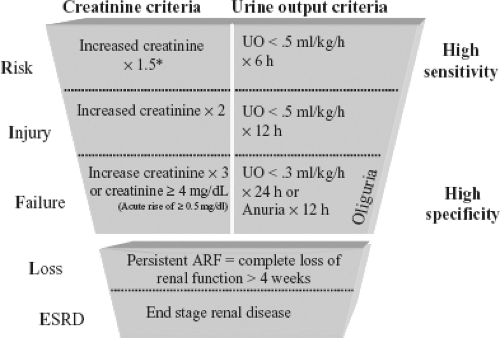Acute Kidney Injury
Feihu Zhou
John A. Kellum
I. Introduction
Acute kidney injury (AKI) is common in critically ill trauma patients and increases mortality. Most often, AKI is part of multiple organ failure and may arise from injuries or sepsis.
The terms acute kidney injury (AKI) and acute renal failure are not synonymous. The term renal failure is reserved for patients who have lost renal function to the point that life can no longer be sustained without intervention, whereas AKI describes patients with earlier or milder forms of acute renal dysfunction and those with overt failure.
II. Definition and Classification
International consensus criteria for AKI use the RIFLE criteria to describe three levels of renal impairment (risk, injury, failure) and two clinical outcomes (loss and end-stage kidney disease, see Figure 37-1). The RIFLE classification system includes separate criteria for serum creatinine (SCrt) and urine output. The criteria which lead to the worst classification define the stage of AKI.
Note that RIFLE-F is present even if the increase in SCrt is <3-fold, so long as the new SCrt is >4.0 mg/dL in the setting of an acute increase of at least 0.5 mg/dL. The shape the figure denotes the fact that more patients (high sensitivity) will be included in the mild category, including some without actually having kidney damage (less specificity). In contrast, at the bottom the criteria are strict and therefore specific, but some patients will be missed.
III. Epidemiology
AKI occurs in 6.3% to 27% of critically ill trauma patients, with mortality ranging from 22% to 95.3%.
Severity of illness. Increased severity of AKI is associated with a step-wise increase in the risk of death. Hospital mortality rates for ICU patients with AKI are approximately: R—9%, I—11%, F–-26% compared to 6% for ICU patients without AKI.
The incidence and the attributed morbidity and mortality of AKI associated with trauma vary widely. For example, in burn patients, the occurrence rate of AKI is 22.5% while it is 9.2% in patients with traumatic brain injury.
Injury severity scores and associated organ failure: In 2010, a matched cohort study utilizing data derived from the National Trauma Data Bank (NTDB, 2007) revealed that of the 94,795 severely injured trauma patients (Injury Severity Score ≥9), 10,478 (11.1%) patients developed at least one complication. The cumulative incidence of renal failure was 1.3% and the crude mortality was 29.3%. Renal failure is one of four complications (cardiovascular, acute respiratory distress syndrome, renal failure, and sepsis) associated with increased mortality (relative risk increase 24%). Plurad et al. reported that although incidence of renal failure was 1.1%, the mortality with renal failure was much higher than the overall mortality in ICU trauma patients (50% vs. 15.4%). Renal failure is associated with a longer duration of mechanical ventilation and stay in ICU, an increased cost of care, and increase in risk of death (>7-fold.)
Etiology. Causes of trauma-associated AKI are often multifactorial.
Early-onset AKI is more likely to be directly attributable to trauma (e.g., shock, direct kidney trauma, rhabdomyolysis, exposure to radiocontrast media, early
intra-abdominal hypertension); whereas delayed-onset AKI is more likely associated with complications such as sepsis and multiple organ dysfunction syndrome (MODS).
In some series, AKI in trauma patients is most often due to crush injuries and rhabdomyolysis, whereas in other reports shock was the most common cause of AKI.
Abdominal trauma and use of furosemide are independent risk factors for AKI.
Renal abnormalities seen on autopsy include death or damage of tubular epithelial cells. Overall, risk factors for trauma-induced AKI include the following:
Severity and duration of shock
Sepsis
Increasing age, especially age >62 years
Greater severity of illness as per APACHE III or SOFA scores
Pre-existing chronic kidney disease
Prior admission to a non-ICU ward in the hospital
Preexisting cardiovascular disease
Emergent surgery
Need for mechanical ventilation
Nephrotoxin use including aminoglycoside antibiotics and radiologic contrast agents
Abdominal injuries—abdominal compartment syndrome
Patient susceptibility. Advanced age is a major determinant of susceptibility to trauma-associated AKI. Once corrected for exposure, AKI frequency and outcomes appear similar for men and women.
Mechanisms of kidney injury. Traditionally, mechanisms of azotemia are divided into pre-, intra- and postrenal. This categorization is not a classification system for AKI. Both pre- and postrenal insults will result in parenchymal (intrarenal) injury if not treated promptly.
Prerenal. The driving force for glomerular filtration is the pressure gradient from the glomerulus to Bowman’s space. Glomerular pressure is dependent on renal blood flow (RBF) and is controlled by combined resistances of renal afferent and efferent arterioles.
Prerenal mechanisms of AKI result in hypoperfusion of the kidney and may be from a number of different causes. Decreased GFR in the face of reduced RBF is an adaptive response. Severe volume depletion or hypotension in the face of a structurally intact nephron will result in decreased GFR and may fulfill the diagnostic criteria for AKI.
Hypovolemia may result from losses from internal or external hemorrhage, gastrointestinal (GI) and cutaneous sources (e.g., burns).
Full access? Get Clinical Tree








